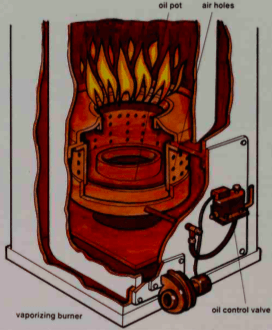Oil Furnace Maintenance
In oil furnaces, fuel oil is sprayed into a combustion chamber where it is ignited, creating heat. Combustion is accomplished by two different methods in the two basic types of residential oil furnaces — the pressure burner and the vaporizing burner.
The pressure burner is the one found in most homes. Oil, as a fine spray, is pumped into the combustion chambers through a nozzle. This spray mixes with air and is ignited by an electric spark.
Vaporizing burners have a pot which contains oil and a flow regulator. A fire is started with an electric spark and the heat from the fire vaporizes the oil. The pool of oil refills as necessary. Air, to keep the fire burning, is fed into the pot through natural draft or through a small fan. Automatic draft regulators can be placed in the vent pipe to ensure a small steady draft for oil-burning purposes.
Your furnace should be checked regularly for a proper fuel and air mix to help avoid soot and to ensure proper combustion.
Many oil furnaces have a stack control that will automatically shut off the oil pump if the fuel spray does not ignite within a given time. The lack of gas passing the control indicates a lack of combustion, and the control will then shut off the pump motor. This prevents an overflow of oil into the combustion chamber. To restart the furnace, follow the instructions in the owner’s manual available from the manufacturer. If, after following the manufacturer’s instructions, the furnace fails to operate, call for professional service.
In addition to a stack control shut-off, there are a number of reasons why a furnace will fail to operate. You can check the following steps first before calling a serviceman.
Check the furnace fuse and replace if necessary, or reset a tripped circuit breaker. If the new fuse blows or the circuit breaker
trips again after resetting, call for professional service.
Check the oil tank to make sure it is full.
Check to see that the emergency switch hasn’t been turned off. This throw switch is usually located close to the furnace on a gray box.
If you have a setback thermostat, check to see that the timer is working. Also check to see that there’s no dirt or corrosion on the thermostat contact points.
OIL FURNACE SHUT-OFF CHECKLIST
• check stack control to see if it has shut off the oil pump
• check the furnace fuse
• check the oil tank to make sure it’s full
• check to see that the emergency switch hasn’t been turned off
• check to see that the timer is working on a setback thermostat
OIL BURNERS

Oil burners come in two styles – the pressure burner (up) and the vaporizing burner (down).

Gas furnaces
Gas is supplied under low pressure to the burner head, where it mixes with air. A single flame jet or multiple jets on the burner head then ignite the gas-air combination. The hot gases are passed into the vent pipe and out through the chimney, while the warmed air circulating around the outside of the combustion chamber is passed out through the ductwork and into the house
A pilot light is used to light the burner jets. The flame of the pilot heats a thermocouple, which converts the heat to an electric current. This current keeps a valve open from the main gas-supp!y line to the burner. If the pilot light goes out, the thermocouple cools off, eliminating the current and forcing the gas-supply-line valve to close. The pilot light can be relighted, but if you’ve never handled the task before, ask the utility company to send a serviceman to instruct you on how to do it.
A gas furnace needs little maintenance. Inspection by the gas company every two or three years to ensure that the chimney and vents are clean, and that the heat exchanger hasn’t developed any cracks, is all that will likely be necessary. However, should an emergency arise, call the gas company for immediate emergency service. If you should smell gas fumes, leave the house immediately and call the gas company from a neighbor’s.